Dry Mix Mortar Market Size
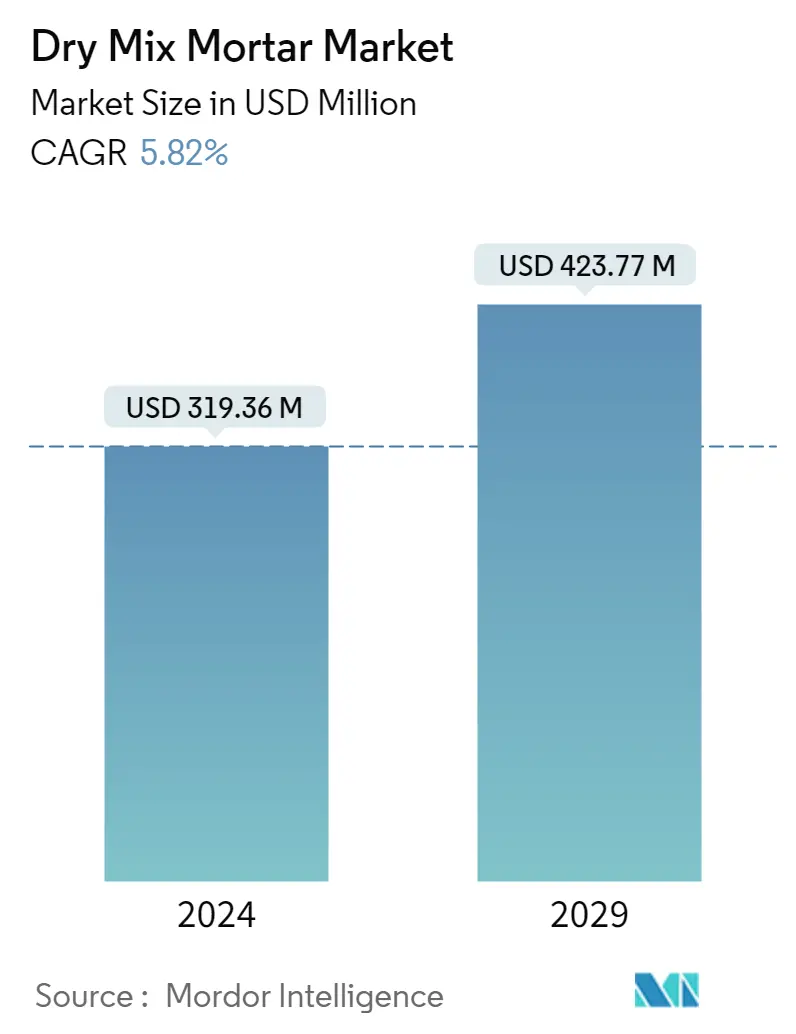
| Study Period | 2017-2027 |
| Market Size (2023) | USD 301.80 Million |
| Market Size (2028) | USD 400.46 Million |
| CAGR (2023 - 2028) | 5.82 % |
| Fastest Growing Market | Asia-Pacific |
| Largest Market | Asia-Pacific |
Major Players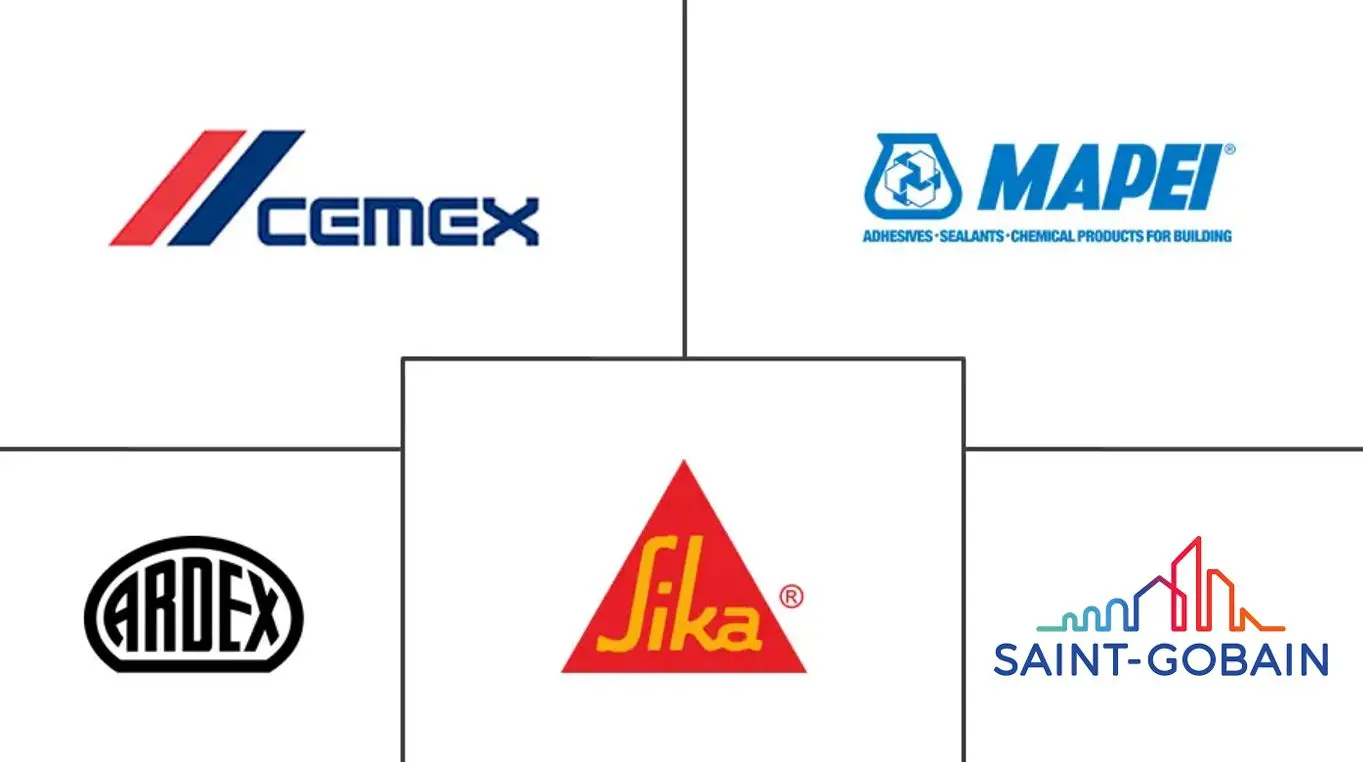
*Disclaimer: Major Players sorted in no particular order |
Need a report that reflects how COVID-19 has impacted this market and its growth?
Dry Mix Mortar Market Analysis
The Dry Mix Mortar Market size is expected to grow from tons 301.80 million in 2023 to tons 400.46 million by 2028, at a CAGR of 5.82% during the forecast period (2023-2028).
The COVID-19 pandemic negatively impacted the market in 2020. However, the construction sector is picking up pace in the post-pandemic scenario. Thus, this will enhance the market demand for dry mix mortar over the coming years.
- Over the medium term, increasing construction activities in the United States and Asia-Pacific are expected to drive the market's growth.
- Simplified mix and apply operation is also a blooming opportunity for the dry mix mortar market.
- The emerging trend of green building certifications will likely act as an opportunity.
- Asia-Pacific dominated the market studied, with the most significant consumption from countries like China, India, and Japan.
Dry Mix Mortar Market Trends
This section covers the major market trends shaping the Dry Mix Mortar Market according to our research experts:
Increasing Demand from the Render Segment
- Rendering has a higher proportion of cement in its composition and is used to coat the exterior surfaces of buildings. Rendering is used on the outside of buildings to improve the appearance of the exterior façade while also providing waterproofing and fireproofing benefits.
- Dry mix products provide excellent technical properties to meet the stringent performance requirements common in the current construction scenario. Additionally, using dry mix mortar products is economical as they reduce potential construction problems by ensuring the long-term integrity of structures with a simple materials approach.
- Dry mixed mortar contains a precise blend of materials and only requires the addition of water to produce a suitable render. Dry mix mortar comprises special additives that improve the workability of renders, help them bond to the background, and reduce the risk of cracking. They can also be used for decorative finishes.
- Rendering is done in almost all construction applications to achieve a smooth or deliberately textured surface. The increasing construction activities worldwide are expected to drive the use of dry mix mortar over the forecast period.
- Therefore, considering the abovementioned factors, the demand in the dry mix mortar market is expected to rise in the render segment.
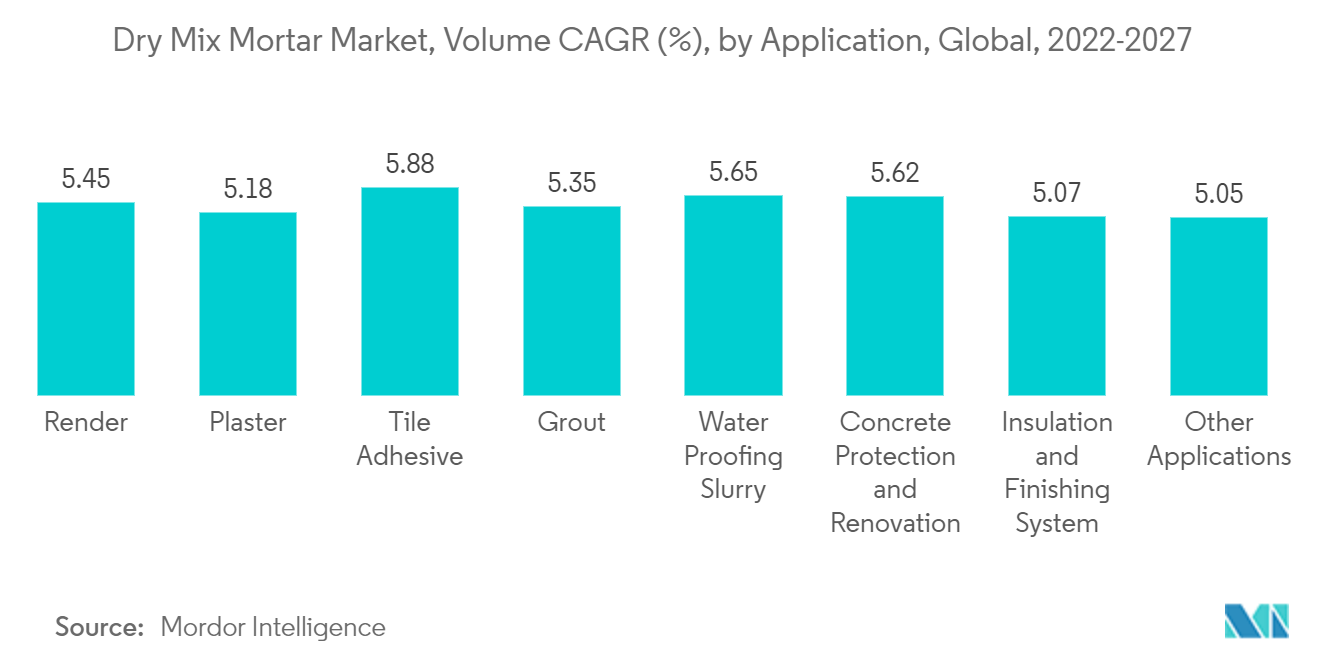
China is Expected to Dominate the Market in the Asia-Pacific Region
- The country's largest construction market, encompassing 20% of all construction investments globally. China is expected to spend nearly USD 13 trillion on buildings by 2030, creating a positive market outlook for construction materials such as dry mix mortar.
- The increased focus on affordable housing by both the public and the private sector may drive growth in the residential construction sector, which is likely to drive market demand.
- China has been majorly driven by ample residential and commercial construction developments and supported by the growing economy. In China, the housing authorities of Hong Kong launched several measures to push start the construction of low-cost housing. The officials aim to provide 301,000 public housing units by 2030.
- Similarly, China will likely witness the construction of 7,000 more shopping centers, estimated to be opened by 2025. Such growth in the construction industry is expected to propel market demand.
- However, the economy looks shaky as the country is dealing with the Evergrande crisis (the company had USD 300 billion of liabilities alone as of June 2021) and a full-fledged Chinese financial crisis, while a recession can’t be ruled out either.
- All factors above are likely to fuel the growth of the dry mix mortar market in China over the forecast period.
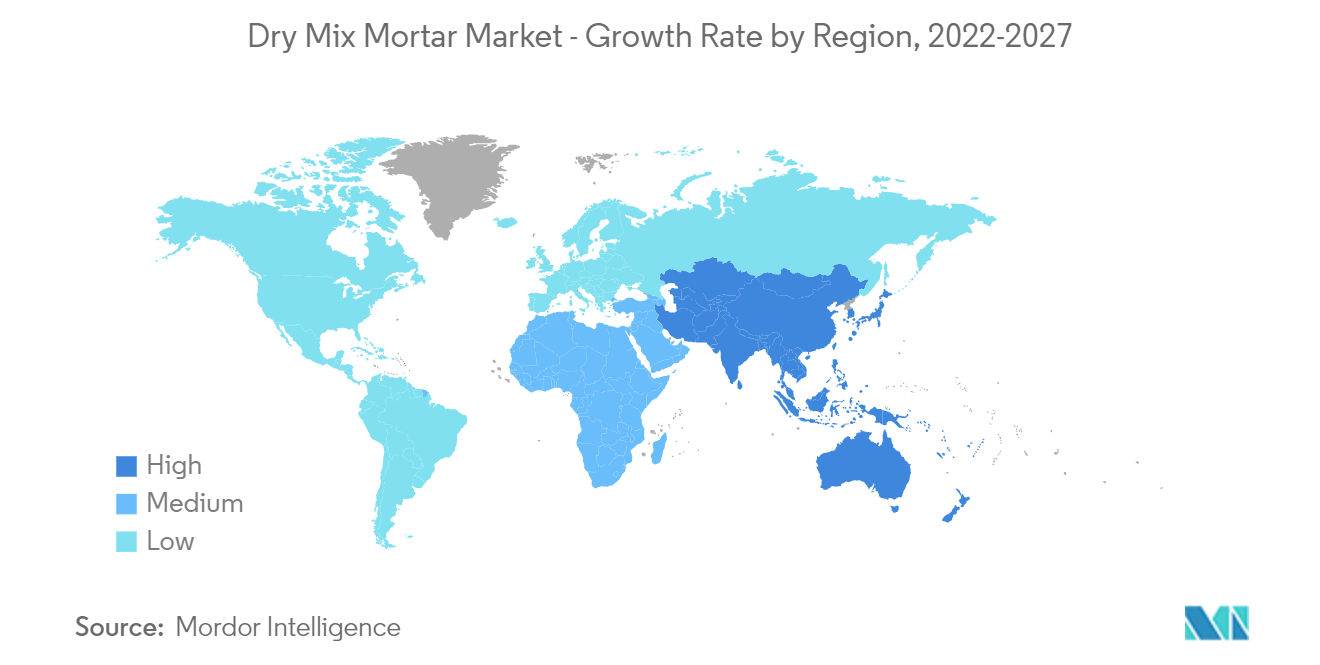
Dry Mix Mortar Industry Overview
The dry mix mortar market is fragmented in nature. Some of the major players (in no particular order) in the market include Sika AG, CEMEX SAB de CV, MAPEI SpA, Ardex Group, and Saint-Gobain, among others.
Dry Mix Mortar Market Leaders
Sika AG
CEMEX S.A.B. de C.V.
MAPEI S.p.A.
Ardex Group
Saint-Gobain
*Disclaimer: Major Players sorted in no particular order
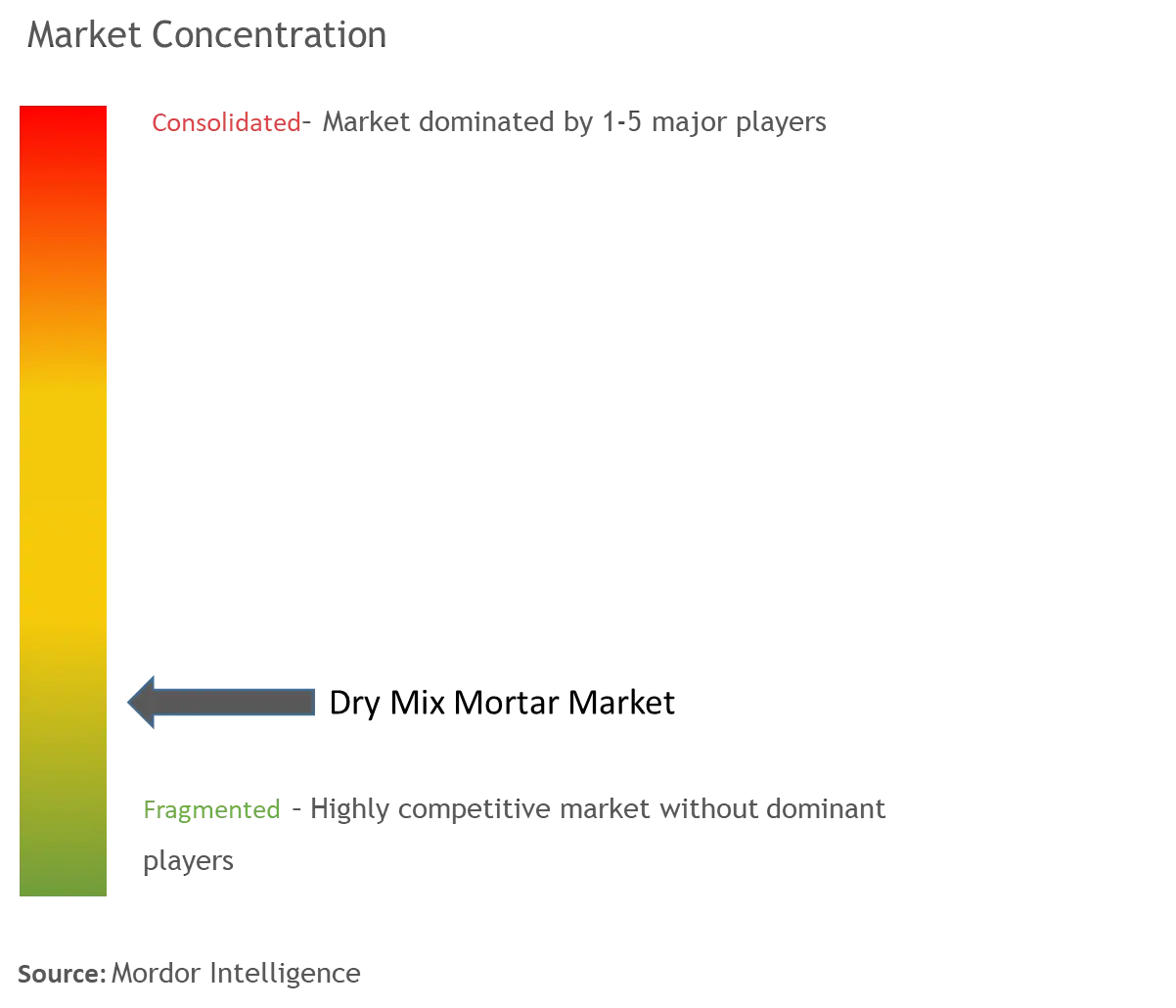
Dry Mix Mortar Market News
- October 2022: Holcim agreed to acquire Izolbet, a leading company in Poland's specialty building solutions market, which will help expand its business by enhancing its product portfolio.
- May 2022: Sika is expanding production capacity in Bolivia, South America, by opening a mortar production facility in Cruz de la Sierra. This expansion will align its capacities with the rising demand from the booming construction market.
Dry Mix Mortar Market Report - Table of Contents
1. INTRODUCTION
1.1 Study Assumptions
1.2 Scope of the Study
2. RESEARCH METHODOLOGY
3. EXECUTIVE SUMMARY
4. MARKET DYNAMICS
4.1 Drivers
4.1.1 Increasing Construction Activities in the United States and Asia-Pacific
4.1.2 Long-term Cost Effectiveness in the Construction Industry
4.1.3 Simplified Mix and Apply Operation
4.2 Restraints
4.3 Industry Value Chain Analysis
4.4 Porter's Five Forces Analysis
4.4.1 Bargaining Power of Suppliers
4.4.2 Bargaining Power of Consumers
4.4.3 Threat of New Entrants
4.4.4 Threat of Substitute Products and Services
4.4.5 Degree of Competition
5. MARKET SEGMENTATION
5.1 By End-user Industry
5.1.1 Residential
5.1.2 Non-residential
5.1.2.1 Commercial
5.1.2.2 Infrastructure
5.1.2.3 Industrial/Institutional
5.1.2.4 Other Non-residential End-user Industries
5.2 By Application
5.2.1 Plaster
5.2.2 Render
5.2.3 Tile Adhesive
5.2.4 Grout
5.2.5 Water Proofing Slurry
5.2.6 Concrete Protection and Renovation
5.2.7 Insulation and Finishing Systems
5.2.8 Other Applications
5.3 By Geography
5.3.1 Asia-Pacific
5.3.1.1 China
5.3.1.2 India
5.3.1.3 Japan
5.3.1.4 South Korea
5.3.1.5 Rest of Asia-Pacific
5.3.2 North America
5.3.2.1 United States
5.3.2.2 Canada
5.3.2.3 Mexico
5.3.3 Europe
5.3.3.1 Germany
5.3.3.2 United Kingdom
5.3.3.3 Italy
5.3.3.4 France
5.3.3.5 Rest of Europe
5.3.4 South America
5.3.4.1 Brazil
5.3.4.2 Argentina
5.3.4.3 Rest of South America
5.3.5 Middle East and Africa
5.3.5.1 Saudi Arabia
5.3.5.2 South Africa
5.3.5.3 Rest of Middle East and Africa
6. COMPETITIVE LANDSCAPE
6.1 Mergers and Acquisitions, Joint Ventures, Collaborations, and Agreements
6.2 Market Ranking Analysis
6.3 Strategies Adopted by Leading Players
6.4 Company Profiles (Overview, Financials, Products and Services, and Recent Developments)
6.4.1 3M
6.4.2 Ardex Group
6.4.3 BASF SE
6.4.4 CEMEX SAB de CV
6.4.5 Colmef Monneli
6.4.6 Conmix Ltd
6.4.7 Grand Aces Ventures Inc.
6.4.8 Henkel AG & Co. KGaA
6.4.9 Knauf Gips KG
6.4.10 Holcim
6.4.11 Laticrete International Inc.
6.4.12 MAPEI SpA
6.4.13 M&P Drymix
6.4.14 Plaxit
6.4.15 Saint-Gobain
6.4.16 Saudi Readymix
6.4.17 Saudi Vetonit Co. Ltd
6.4.18 Sika AG
6.4.19 The Ramco Cements Limited
6.4.20 UltraTech Cement Ltd
6.4.21 Wuensch Plaster
7. MARKET OPPORTUNITIES AND FUTURE TRENDS
7.1 Emerging Trend of Green Building Certifications
Dry Mix Mortar Industry Segmentation
Dry mix mortar is produced by mixing various raw materials, including sand, limestone powder, binders like cement, hydrated lime, white cement, and gypsum, and additives like methylcellulose, synthetic resin, hydrophobic agent, and others.
The dry mix mortar market is segmented by end-user industry, application, and geography. By end-user industry, the market is segmented into residential and non-residential. By application, the market is segmented into plaster, render, tile adhesive, grout, waterproofing slurry, concrete protection and renovation, insulation and finishing systems, and other end-user industries. The report also covers the size and forecasts for the market in 15 countries across major regions. For each segment, the market sizing and forecasts have been done based on volume (kiloton).
| By End-user Industry | ||||||
| Residential | ||||||
|
| By Application | |
| Plaster | |
| Render | |
| Tile Adhesive | |
| Grout | |
| Water Proofing Slurry | |
| Concrete Protection and Renovation | |
| Insulation and Finishing Systems | |
| Other Applications |
| By Geography | |||||||
| |||||||
| |||||||
| |||||||
| |||||||
|
Dry Mix Mortar Market Research FAQs
How big is the Dry Mix Mortar Market?
The Dry Mix Mortar Market size is expected to reach USD 301.80 million in 2023 and grow at a CAGR of 5.82% to reach USD 400.46 million by 2028.
What is the current Dry Mix Mortar Market size?
In 2023, the Dry Mix Mortar Market size is expected to reach USD 301.80 million.
Who are the key players in Dry Mix Mortar Market?
Sika AG, CEMEX S.A.B. de C.V., MAPEI S.p.A., Ardex Group and Saint-Gobain are the major companies operating in the Dry Mix Mortar Market.
Which is the fastest growing region in Dry Mix Mortar Market?
Asia-Pacific is estimated to grow at the highest CAGR over the forecast period (2023-2027).
Which region has the biggest share in Dry Mix Mortar Market?
In 2023, the Asia-Pacific accounts for the largest market share in the Dry Mix Mortar Market.
Dry Mix Mortar Industry Report
Statistics for the 2023 Dry Mix Mortar market share, size and revenue growth rate, created by Mordor Intelligence™ Industry Reports. Dry Mix Mortar analysis includes a market forecast outlook to 2028 and historical overview. Get a sample of this industry analysis as a free report PDF download.
